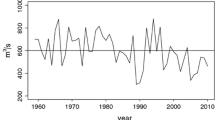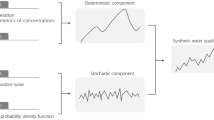Abstract
River flow data are usually subject to several sources of discontinuity and inhomogeneity. An example is seasonality, because climatic oscillations occurring on inter-annual timescale have an obvious impact on the river flow. Further sources of alteration can be caused by changes in reservoir management, instrumentation or even unexpected shifts in climatic conditions. When such changes are ignored the results of a statistical analysis can be strongly misleading, so flexible procedures are needed for building the appropriate models, which may be very complex. This paper develops an automatic procedure to estimate the number and locations of changepoints in Periodic AutoRegressive (PAR) models, which have been extensively used to account for seasonality in hydrology. We aim at filling the literature gap on multiple changepoint detection by allowing several time segments to be detected, inside of which a different PAR structure is specified, with the resulting model being employed to successfully capture the discontinuities of river flow data. The model estimation is performed by optimization of an objective function based on an information criterion using genetic algorithms. The proposed methodology is evaluated by means of simulation studies and it is then employed in the analysis of two river flows: the South Saskatchewan, measured at Saskatoon, Canada, and the Colorado, measured at Lees Ferry, Arizona. For these river flows we build changepoint models, discussing the possible events that caused discontinuity, and evaluate their forecasting accuracy. Comparisons with the literature on river flow analysis and on existing methods for changepoint detection confirm the efficiency of our proposal.



Source: South East Alberta Watershed Alliance


Source: U.S. department of the interior











Similar content being viewed by others
References
Aue A, Horváth L (2013) Structural breaks in time series. J Time Ser Anal 34:1–16
Bai J, Perron P (1999) Estimating and testing linear models with multiple structural changes. Econometrica 66:47–78
Baragona R, Battaglia F, Poli I (2011) Evolutionary statistical procedures. Oxford University Press, Oxford
Battaglia F, Protopapas MK (2012a) An analysis of global warming in the alpine region based on nonlinear nonstationary time series models. Stat Methods Appl 21(3):315–334
Battaglia F, Protopapas MK (2012b) Multi-regime models for nonlinear nonstationary time series. Comput Stat 27:319–341
Bentarzi M, Hallin M (1993) On the invertibility of periodic moving-average models. J Time Ser Anal 15:263–268
Box GEP, Jenkins GM (1970) Time series analysis, forecasting and control. Holden-Day, San Francisco
Brockwell PJ, Davis RA (1991) Time series: theory and methods. Springer, Berlin
Buishand TA (1984) Tests for detecting a shift in the mean of hydrological time series. J Hydrol 75:51–69
Cobb GW (1978) The problem of the Nile: conditional solution to a changepoint problem. Biometrika 65:243–252
Davis RA, Lee TCM, Rodriguez-Yam GA (2006) Structural break estimation for nonstationary time series models. J Am Stat Assoc 473:223–239
Davis RA, Lee TCM, Rodriguez-Yam GA (2008) Break detection for a class of nonlinear time series models. J Time Ser Anal 29:834–867
Delleur JW, Tao PC, Kavvas ML (1976) An evaluation of the practicality and complexity of some rainfall and runoff time series models. Water Resour Res 12(5):953–970
Doerr B, Fischer P, Hilbert A, Witt C (2017) Detecting structural breaks in time series via genetic algorithms. Soft Comput 21(16):4707–4720
Durdu OF (2010) Application of linear stochastic models for drought forecasting in the Buüyük Menderes river basin, western Turkey. Stoch Environ Res Risk Assess 24:1145–1162
Eiben AE, Smith JE (2003) Introduction to evolutionary computing. Springer, Berlin
Eshete Z, Vandewiele GL (1992) Comparison of non-Gaussian multicomponent and periodic autoregressive models for river flow. Stoch Hydrol Hydraul 6:223–238
Fayaed SS, El-Shafie A, Jaafar O (2013) Reservoir-system simulation and optimization techniques. Stoch Environ Res Risk Assess 27:1751–1772
Franses PH, Paap R (2004) Periodic time series models. Oxford University Press, Oxford
Gober P, Wheater HS (2014) Socio-hydrology and the science-policy interface: a case study of the Saskatchewan River basin. Hydrol Earth Syst Sci 18:1413–1422
Goldberg DE (1989) Genetic algorithms in search, optimization and machine learning. Addison-Wesley, Boston
Hansen BE (2001) The new econometrics of structural change: dating breaks in U.S. labor productivity. J Econ Perspect 15:117–128
Hipel KW, McLeod AI (1994) Time series modelling of water resources and environmental systems. Elsevier, Amsterdam
Hipel KW, McLeod AI, McBean EA (1977) Stochastic modelling of the effects of reservoir operation. J Hydrol 32:97–113
Holland JH (1975) Adaptation in natural and artificial systems. University of Michigan Press, Ann Arbor
Hyndman RJ, Koehler AB (2006) Another look at measures of forecast accuracy. Int J Forecast 22:679–688
Jeong C, Kim J (2013) Bayesian multiple structural change-points estimation in time series models with genetic algorithm. J Korean Stat Soc 42:459–468
Kawahara Y, Sugiyama M (2012) Sequential change-point detection based on direct density-ratio estimation. Stat Anal Data Min 5(2):114–127
Koutroumanidis T, Sylaios G, Zafeiroiou E, Tsihrintzis V (2009) Genetic modeling for the optimal forecasting of hydrologic time-series: application in Nestos River. J Hydrol 368:156–164
Krause P, Boyle DP, Bäse F (2005) Comparison of different efficiency criteria for hydrological model assessment. Adv Geosci 5:89–97
Kreinovich V, Quintana C, Fuentes O (1993) Genetic algorithms: what fitness scaling is optimal? Cybern Syst 24(1):9–26
Li S, Lund R (2012) Multiple changepoint detection via genetic algorithms. J Clim 25:674–686
Lu Q, Lund R (2007) Simple linear regression with multiple level shifts. Can J Stat 37:447–458
Lu Q, Lund R, Lee TCM (2010) An MDL approach to the climate segmentation problem. Ann Appl Stat 4:299–319
Lund RB, Basawa IV (1999) Modeling and inference for periodically correlated time series. In: Gosh S (ed) Asymptotics, nonparametrics and time series. Statistics : textbooks and monographs, vol 158. Marcel Dekker, New York, pp 37–62
Lund RB, Basawa IV (2000) Recursive prediction and likelihood evaluation for periodic ARMA models. J Time Ser Anal 21:75–93
Lund RB, Wang XL, Lu Q, Reeves J, Gallagher C, Feng Y (2007) Changepoint detection in periodic and autocorrelated time series. J Clim 20:5178–5190
Maçaira PM, Oliveira FLC, Ferreira PGCF, de Almeida FVN, Souza RC (2017) Introducing a causal PAR(p) model to evaluate the influence of climate variables in reservoir inflows: a brazilian case. Pesqui Oper 37:107–128
Matteson DS, James NA (2014) A nonparametric approach for multiple change point analysis of multivariate data. J Am Stat Assoc 109(505):334–345
McCabe GJ, Wolock DM, Pederson GT, Woodhouse CA, McAfee S (2017) Evidence that recent warming is reducing Upper Colorado river flows. Earth Interact 21:1–14
McKee TB, Doesken NJ, Kleist J, Shrier CJ, Stanton WP (2000) A history of drought in Colorado: lessons learned and what lies ahead. Colo Water Resour Res Inst 9:1–20
McLeod AI (1993) Parsimony, model adequacy, and periodic autocorrelation in time series forecasting. Int Stat Rev 61:387–393
McLeod AI (1994) Diagnostic checking periodic autoregression models with applications. J Time Ser Anal 15:221–233
McLeod AI, Gweon H (2013) Optimal deseasonalization for monthly and daily geophysical time series. J Environ Stat 4:1–11
Mishra AK, Desai VR (2005) Drought forecasting using stochastic models. Stoch Environ Res Risk Assess 19:326–339
Mondal MS, Wasimi SA (2006) Generating and forecasting monthly flows of the Ganges river with PAR model. J Hydrol 323:41–56
Noakes DJ, McLeod AI, Hipel KW (1985) Forecasting monthly riverflow time series. Int J Forecast 1:179–190
Novak K, Hoerling M, Rajagopalan B, Zagona E (2012) Colorado river basin hydroclimatic variability. J Clim 25:4389–4403
Pereira G, Veiga Á (2018) Par (p)-vine copula based model for stochastic streamflow scenario generation. Stoch Environ Res Risk Assess 32(3):833–842
Piyoosh AK, Ghosh SK (2017) Effect of autocorrelation on temporal trends in rainfall in a valley region at the foothills of Indian Himalayas. Stoch Environ Res Risk Assess 31:2075–2096
Prairie J, Callejo R (2005) Natural flow and salt computation methods, calendar years 1971–1995. All US government documents (Utah Regional Depository). Paper 135. https://digitalcommons.usu.edu/govdocs/135
Rao AR, Tirtotjondro W (1996) Investigation of changes in characteristics of hydrological time series by Bayesian methods. Stoch Hydrol Hydraul 101:295–317
Rissanen J (1978) Modeling by shortest data description. Automatica 14:465–471
Robinson PM (2003) Time series with long memory. In: Advanced texts in econometrics. Oxford University Press
Shaochuan L (2019) A Bayesian multiple changepoint model for marked poisson processes with applications to deep earthquakes. Stoch Environ Res Risk Assess 33(1):59–72
Song L, Bondon P (2013) Structural changes estimation for strongly-dependent processes. J Stat Comput Simul 83:1783–1806
Song S, Singh VP (2010) Frequency analysis of droughts using the Plackett copula and parameter estimation by genetic algorithm. Stoch Environ Res Risk Assess 24:783–805
Srivastav R, Srinivasan K, Sudheer KP (2016) Simulation-optimization framework for multi-site multi-season hybrid stochastic streamflow modeling. J Hydrol 542:506–531
Tong H (1990) Non-linear time series: a dynamical system approach. Oxford University Press, Oxford
Ursu E, Pereau JC (2015) Application of periodic autoregressive process to the modeling of the Garonne river flows. Stoch Environ Res Risk Assess 30(7):1785–1795
Van Steeter MM, Pitlick J (1998) Geomorphology and endangered fish habitats of the upper Colorado river. Historic changes in streamflow, sediment load, and channel morphology. Water Resour Res 34:287–302
Vecchia AV (1985a) Periodic autoregressive-moving average (PARMA) modeling with applications to water resources. Water Resour Bull 21:721–730
Vecchia AV (1985b) Maximum likelihood estimation for periodic autoregressive moving average models. Technometrics 27:375–384
Wang Y, Guo S, Chen H, Zhou Y (2014) Comparative study of monthly inflow prediction methods for the three Gorges reservoir. Stoch Environ Res Risk Assess 28:555–570
Woodhouse CA, Pederson GT (2018) Investigating runoff efficiency in upper Colorado river streamflow over past centuries. Water Resour Res 54:286–300
Woodhouse CA, Pederson GT, Morino K, McAfee S, McCabe GJ (2016) Increasing influence of air temperature on upper Colorado river streamflow. Geophys Res Lett 43:2174–2181
Yau CY, Tang CM, Lee TCM (2015) Estimation of multiple-regime threshold autoregressive models with structural breaks. J Am Stat Assoc 511:1175–1186
Acknowledgements
The authors wish to thank Francesco Battaglia for his valuable and constructive remarks, QiQi Lu for providing us with the Fortran code related to the algorithm in Lu et al. (2010) and several anonymous referees for their useful comments. Part of this work has been carried out with the financial support of the CNRS and the French National Research Agency (ANR) in the framework of the Investments for the Future Program, within the Cluster of Excellence COTE (ANR-10-LABX-45).
Author information
Authors and Affiliations
Corresponding author
Ethics declarations
Conflict of interest
The authors declare that they have no conflict of interest.
Additional information
Publisher's Note
Springer Nature remains neutral with regard to jurisdictional claims in published maps and institutional affiliations.
Rights and permissions
About this article
Cite this article
Cucina, D., Rizzo, M. & Ursu, E. Multiple changepoint detection for periodic autoregressive models with an application to river flow analysis. Stoch Environ Res Risk Assess 33, 1137–1157 (2019). https://doi.org/10.1007/s00477-019-01692-0
Published:
Issue Date:
DOI: https://doi.org/10.1007/s00477-019-01692-0




